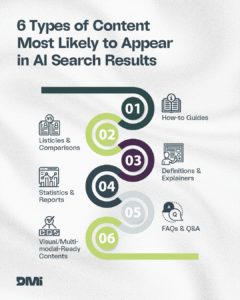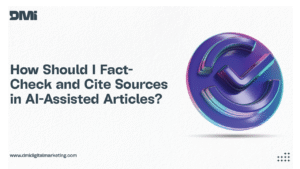Jump to Section
ToggleContent may be king, but not all content wears the crown. In this AI search era, certain types of content perform better than others on Google AI Overviews, AI Mode, ChatGPT and other similar AI platforms.
To stay visible in AI search engines, we’ve pulled together six types of content that are more likely to appear in what’s now being called zero-click search results. This list draws from Google’s recommendation and observation from current AI search behavior.

1. How-to Guides & Tutorials:
A how-to guide and tutorial is a form of content that contains clear information and step-by-step instructions on a subject matter.
These two can be presented either as written or video content.
To execute this, you must understand your target audience, create actionable tips, and use clear language and visuals for proper clarity.
Why do How-to guides and Tutorials work for AI search?
The how-to guides and tutorials that get featured by an AI search engine work because:
- They are well structured so that an AI model can easily understand.
- Provide direct answers.
- Present step-by-step instructions.
For example, a blog titled “How to get clients for my marketing agency” can appear in an AI search as a listicle, providing step-by-step instructions on how to secure your own clients.
2. Listicles & Comparisons
A listicle is a form of content or an article that is structured in a list format to provide information. This can be optimized for Google’s generative AI search experience by using a numerical format or bullet points, with clear and logical headings for each point, and incorporating structured data.
Why do Listicles work for AI search?
- Listicles contain structured data with detailed explanations that enable AI to easily process and present them as answers.
- They are easy to scan and read.
Example: Asking AI, “10 best AI tools to know in 2025 with their pros and cons.” AI would provide a list of available tools, along with their advantages and disadvantages.
3. Definitions & Explainers
A definition is the true meaning or statement of what a word or concept means, while an explainer is an idea or subject explained in a very detailed way. An example of this is an article written to inform readers on how to encourage people to continue searching for information on your site.
Why does Definition & Explainer work for AI search?
- They use simple and straightforward language to convey complex ideas.
- They follow a structured format, making it easy for AI models to scan and extract answers.
- They provide accurate and up-to-date information, often citing credible sources.
Example: Ask Google what is “evergreen and trend-based campaign” today, and you will find the definition you are looking for straight in the AI Overview. Luckily, you will also find that two of DMi Agency blogs is referenced in the AI Overview.

4. Statistics, Research & Reports
Statistics, research, and reports often appear in AI search results to support answers. A search query result can contain research, statistics, and reports in the AI Overview or AI Mode. These statistics are compiled from multiple websites relevant to the user’s query.
Why does Statistics, Research & Reports work for AI search?
- Users directly incorporate terms like “research,” “statistics,” and “report” into their searches to obtain accurate information, as they now have clear conversations with search engines, such as Google, rather than relying solely on keywords.
- AI is trained to understand a vast amount of data to provide answers
- AI recognizes the significance of research, stats, and reports within web content.
For example, when Google was asked about the “statistics on AI usage in content for 2025,” Google provided different statistics extracted from the web.
5. FAQs & Q&A Content
Frequently Asked Questions (FAQs) and Question and Answer (Q&A) are content pieces that provide brief/short, valuable, informative answers to common questions.
This can be part of a blog post or a section on your website
Why do FAQs and Q&A work for AI search?
- A straightforward answer is provided directly after the question, making it easy for AI models to scan and understand, and it can be listed as an answer
- An AI algorithm extracts the most relevant answer from FAQs
- When users ask a question, the AI algorithm matches the query to relevant FAQs and extracts the most straightforward answer.
Example: FAQs like “when was the DMi – Digital Marketing Agency founded?” might bring up all the DMi Agency information it knows, stating the year each was established.
6. Visual & Multimodal-Ready Content
With AI search evolving beyond text, content that combines written information with visuals is becoming more visible in results. People are no longer just typing queries; they’re snapping photos, uploading images, or asking AI questions about what they’re seeing.
According to Google’s own guidance, AI search tools can now interpret pictures and return helpful results with links for deeper exploration.
To position your content for this shift:
-
Add high-quality images, diagrams, or videos to your written content
-
Use alt text and context-rich captions
-
Make sure your Business Profile and Merchant Center details are updated
-
Ensure visuals support the topic instead of acting as filler
Why Visual & Multi-modal Content matters for AI Search
When someone uploads an image or uses visual search, AI needs content it can interpret and pull from. Pages with both strong text and high-quality visuals are far more likely to be featured.
Example: Someone uploads a photo of a damaged sneaker and asks, “How do I fix this?”
AI may surface a blog post that includes repair instructions plus an image or short video tutorial.
FAQs
What types of content are most likely to appear in AI search results?
Listicles, how-to guides, FAQs, definitions, and Q&A content are among the top types of content that are likely to appear in AI search results.
Why do these types of content perform well in AI Search?
These types of content provide direct answers to user queries, are structured for easy extraction, and offer valuable insights and information.
How can I optimize my content for AI Search?
Focus on creating high-quality, structured content that provides direct answers to user queries, and incorporate relevant keywords and phrases to improve visibility.
How Important is it to rank for AI Search Today?
Ranking for search today is as important as eating your three square meals per day. You need a rank on AI searches to beat your competition.
Does Ranking For AI Search Have Any Impact on My Website?
Yes, it does because users are most likely to click on the links from which the answers provided in the AI Overview are extracted, and in turn will boost your click-through rate.
Rank in AI Search Result Today!
To increase your content’s visibility in AI search results, focus on creating high-quality, structured content that provides direct answers to user queries. By incorporating listicles, how-to guides, FAQs, definitions, and Q&A content into your strategy, you can improve your chances of appearing in AI search results, drive more traffic to your site and acquire new customers.
Author
-

Yusuf Mutiat Temitope is a result-driven content writer with years of experience in conversion-driven content writing. Mutiat writes on digital marketing to drive business growth, provide insights on trending topics for the audience, and increase customer engagement.
View all posts SEO Content Writer






